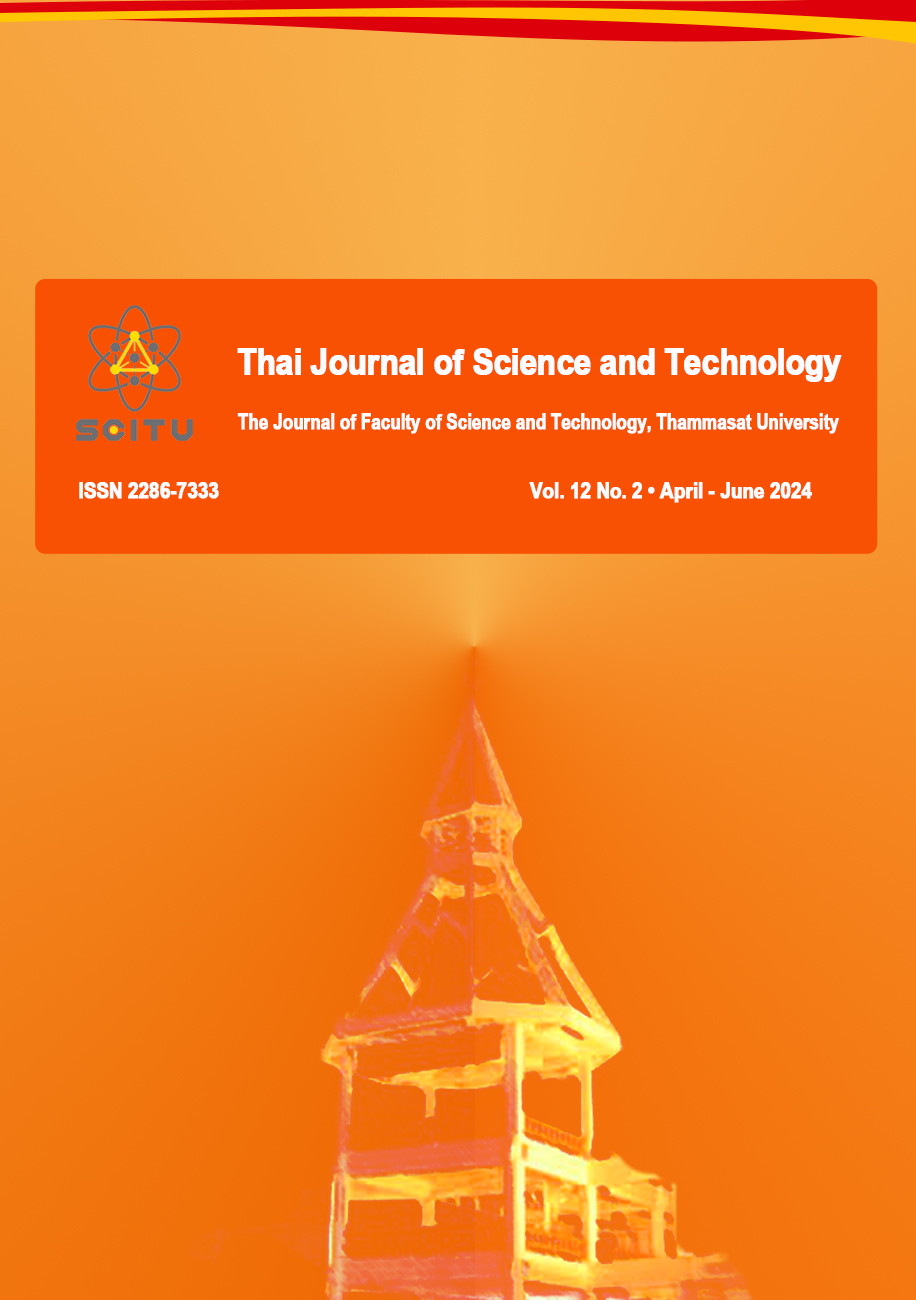Assessment of Genetic Diversity and Relationships of Anoectochilus burmannicus and Related Species in Thailand Using ISSR Marker
Main Article Content
Abstract
Anoectochilus burmannicus, a terrestrial orchid, has a potential as medicinal plant. Because its habitat is confined and deforested, it is diminished in nature. Therefore, its habitat located in Chiang Mai province, Thailand, is protected as a conservation area. However, genetic diversity of this plant in the area is still unknown. The objective of the study was to assess the genetic relationships and diversity of A. burmannicus and related species collected from northern Thailand. Thirty-three DNA samples of A. burmannicus, A. albolineatus, A. roxburghii, A. elwesii and O. lanceolatus were analyzed using 7 inter-simple sequence repeat (ISSR) primers. A total of 82 bands were obtained with 98.9% polymorphism. All 5 studied species were clearly separated and clustered into 2 groups. Nei’s genetic diversity (H) and Shannon information index (I) of A. burmannicus were 0.22 and 0.33, respectively, which revealed the moderate genetic diversity. For A. albolineatus, A. roxburghii and A. elwesii, H and I were ranged from 0.12-0.15 and 0.19-0.23, respectively. While, genetic diversity of O. lanceolatus was low (H=0.07, I=0.10). The results shown here were the first report about genetic relationships and diversity of Anoectochilus sp. in Thailand. These findings might provide essential information for developing genetic conservation strategy in these studied species in Thailand.
Article Details

This work is licensed under a Creative Commons Attribution-NonCommercial-NoDerivatives 4.0 International License.
บทความที่ได้รับการตีพิมพ์เป็นลิขสิทธิ์ของคณะวิทยาศาสตร์และเทคโนโลยี มหาวิทยาลัยธรรมศาสตร์ ข้อความที่ปรากฏในแต่ละเรื่องของวารสารเล่มนี้เป็นเพียงความเห็นส่วนตัวของผู้เขียน ไม่มีความเกี่ยวข้องกับคณะวิทยาศาสตร์และเทคโนโลยี หรือคณาจารย์ท่านอื่นในมหาวิทยาลัยธรรมศาสตร์ ผู้เขียนต้องยืนยันว่าความรับผิดชอบต่อทุกข้อความที่นำเสนอไว้ในบทความของตน หากมีข้อผิดพลาดหรือความไม่ถูกต้องใด ๆ
References
Abd-dada, H., Bouda, S., Khachtib, Y., Bella, Y.A., & Haddioui, A. (2023). Use of ISSR markers to assess the genetic diversity of an endemic plant of Morocco (Euphorbia resinifera O. Berg). Journal of Genetic Engineering and Biotechnology, 21(1), 91. https://doi.org/10.1186/s43141-023-00543-4
Bhattacharyya, P., Kumaria, S., & Tandon, P. (2015). Applicability of ISSR and DAMD markers for phyto-molecular characterization and association with some important biochemical traits of Dendrobium nobile, an endangered medicinal orchid. Phytochemistry, 117, 306-316. https://doi.org/https://doi.org/10.1016/j.phytochem.2015.06.022
Budluang, P., Pitchakarn, P., Ting, P., Temviriyanukul, P., Wongnoppawich, A., & Imsumran, A. (2017). Anti-inflammatory and anti-insulin resistance activities of aqueous extract from Anoectochilus burmannicus. Food Science & Nutrition, 5(3), 486-496. https://doi.org/10.1002/fsn3.416
Cai, J., Zhao, L., & Zhu, E. (2015). A new flavonol triglycoside derived from Anoectochilus elwesii on stimulating glucose uptake in insulin-induced human HepG2 cells. Natural Product Research, 29(15), 1414-1418. https://doi.org/10.1080/14786419.2014.1003135
Das, A., Kesari, V., Satyanarayana, V.M., Parida, A., & Rangan, L. (2011). Genetic relationship of Curcuma species from Northeast India using PCR-based markers. Moleculat Biotechnology, 49(1), 65-76. https://doi.org/10.1007/s12033-011-9379-5
Du, X.-M., Irino, N., Furusho, N., Hayashi, J., & Shoyama, Y. (2008). Pharmacologically active compounds in the Anoectochilus and Goodyera species. Journal of Natural Medicines, 62(2), 132-148. https://doi.org/10.1007/s11418-007-0169-0
Huang, J.C., Wan, S.Q., Chen, Y., Li, L.H., Zhang, Z.L., Zhu, J.J., Wu, M., Xing, B.C., Shao, Q.S., & Lu, C.F. (2023). Genetic diversity of Anoectochilus roxburghii based on ISSR and SRAP molecular markers. Journal of Zhejiang Agricultural and Forestry University, 40(1), 22–29. https://doi.org/10.11833/j.issn.2095-0756.20220473
Hwang, S.-K., & Kim, Y.-M. (2000). A Simple and Reliable Method for Preparation of Cross-Contamination- Free Plant Genomic DNA for PCR-Based Detection of Transgenes. Journal of Biochemistry and Molecular Biology, 33, 537-540.
Karinchai, J., Budluang, P., Temviriyanukul, P., Ting, P., Nuchuchua, O., Wongnoppavich, A., Imsumran, A., & Pitchakarn, P. (2021). Bioassay-guided study of the anti-inflammatory effect of Anoectochilus burmannicus ethanolic extract in RAW 264.7 cells. Journal of Ethnopharmacology, 280, 114452. https://doi.org/https://doi.org/10.1016/j.jep.2021.114452
Nei, M. (1973). Analysis of gene diversity in subdivided populations. Proceedings of the National Acadamy of Sciences of the United States of America, 70(12), 3321-3323. https://doi.org/10.1073/pnas.70.12.3321
Page, R.D.M. (1996). Tree View: An application to display phylogenetic trees on personal computers. Bioinformatics, 12(4), 357-358. https://doi.org/10.1093/bioinformatics/12.4.357
Parab, G.V., Krishnan, S., Janarthanam, M.K., Sivaprakash, K.R., & Parida, A. (2008). ISSR and RAPD Markers Assessed Genetic Variation of Aerides maculosum — an Epiphytic Orchid from Goa, India. Journal of Plant Biochemistry and Biotechnology, 17(1), 107-109. https://doi.org/10.1007/BF03263271
Pavlícek, A., Hrdá, S., & Flegr, J. (1999). Free-Tree--freeware program for construction of phylogenetic trees on the basis of distance data and bootstrap/jackknife analysis of the tree robustness. Application in the RAPD analysis of genus Frenkelia. Folia Biologica (Praha), 45(3), 97-99.
Peyachoknagul, S. (2009). DNA marker: from basic to application (1 ed.). Kasetsart University Press. (in Thai)
Sakulsathaporn, A., Choradet, I., & Roopkham, C. (2023). Genetic Diversity of the Endemic Species Phanera sirindhorniae in the Mekong Basin of Thailand Based on ISSR Markers. Trends in Sciences, 20(12), 7053. https://doi.org/10.48048/tis.2023.7053
Sitthisajjathum, S. (2007). Wild orchid of Thailand (3rd Edition ed.). Baanlaesuan. (in Thai)
Sukjit, S., Sakulsingharoj, C., Nonthasawatsri, C., & Khemkladngoen, N. (2019). Application of Inter-Simple Sequence Repeat (ISSR) Markers for Verification of Interspecific Hybrids between Paracurcuma and Eucurcuma. Thai Journal of Science and Technology, 8(3), 287-299. https://doi.org/https://doi.org/10.14456/tjst.2019.37 (in Thai)
Taheri, S., Abdullah, T.L., Abdullah, N.A., & Ahmad, Z. (2012). Genetic relationships among five varieties of Curcuma alismatifolia (Zingiberaceae) based on ISSR markers. Genetics and Molecular Research, 11(3), 3069-3076. https://doi.org/10.4238/2012.August.31.4
Tran, T.H.I., Pham, M., Huong, T., Widiarsih, S., & Ho, V.T. (2022). Investigation of the genetic diversity of jewel orchid in Vietnam using RAPD and ISSR markers. Biodiversitas Journal of Biological Diversity, 23(9), 4816-4825. https://doi.org/10.13057/biodiv/d230950
Ueno, S., Rodrigues, J.F., Alves-Pereira, A., Pansarin, E.R., & Veasey, E.A. (2015). Genetic variability within and among populations of an invasive, exotic orchid. AoB PLANTS, 7. https://doi.org/10.1093/aobpla/plv077
Yang, Y., Tang, J., Zou, R., Luo, Y., Deng, Z., Li, D., Chai, S., & Wei, X. (2023). The Genetic Diversity and Genetic Structure of the Germplasm Resources of the Medicinal Orchid Plant Habenaria dentata. Genes, 14(9), 1749. https://www.mdpi.com/2073-4425/14/9/1749
Ye, S., Shao, Q., & Zhang, A. (2017). Anoectochilus roxburghii: A review of its phytochemistry, pharmacology, and clinical applications. Journal of Ethnopharmacology, 209, 184-202. https://doi.org/10.1016/j.jep.2017.07.032
Zhang, F., Lv, Y., Dong, H., & Guo, S. (2010). Analysis of Genetic Stability through Intersimple Sequence Repeats Molecular Markers in Micropropagated Plantlets of Anoectochilus formosanus HAYATA, a Medicinal Plant. Biological & pharmaceutical bulletin, 33, 384-388. https://doi.org/10.1248/bpb.33.384


